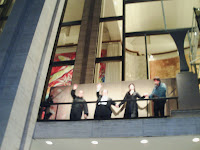
by Dwight Casimere
A sheet inserted in the program notes prefacing The Chicago Symphony Orchestra’s performance of Johannes Brahms A German Requiem (Ein deutsches Requiem, in German) states, in part, “Brahms’s A German Requiem is music of consolation, written to comfort in times of loss. In response, the Chicago Symphony Orchestra and Chorus and Music Director Designate Riccardo Muti dedicate these performances "….to the memory of Chicago youth who have lost their lives to senseless acts of violence and to those left behind.”
Brahms's Requiem contains solemn words that have both religious and social purpose. That is exactly how Muti & Company approached one of the most deeply humanistic and spiritual compositions of the Classical repertory written by a man who was an admitted agnostic. Maestro Muti forewent the customary baton, choosing instead to conduct with his bare hands, as if shaping and molding the sounds that emitted from the orchestra and chorus. Indeed, he had the deft touch of a Michelangelo crafting the frescos of The Creation.
From the opening solemn chords, concentrated in the violas and sustaining notes in the lower organ register, the orchestra and chorus embarked upon a journey of emotional and spiritual discovery that swept the capacity audience in waves of ecstasy and revelation. Muti motioned as often to the chorus as he did to the orchestra, urging them on to new heights, eliciting delicate nuances of sound.
Muti has an uncanny knack for finding the inner voice of a piece and letting it ring forth. This was evidenced in the opening passage,” Blessed are those who mourn “(Selig sind, die da Leid tragen) and later in the fourth setting in the lovely passage that precedes the chorus’ rendering of the words of Psalm 84, “How lovely are your dwellings “(Wie lieblich sine deine Wohnungen). Muti’s entire body shimmered from his flowing dark locks to his heels as the French horns emerged for a brief, but ravishing declaration. The chorus sang beautifully of the “body and soul” being ushered into “the courts of the Lord.”
There was a moment when the sound of the chorus and the woodwind section merged to become a single voice. It was spine chilling.
A second later, Muti had the orchestra fell back to achieve the softest of pianissimos without taking so much as a musical breath. It was masterful.
Not even minute accents and flourishes escaped the interpretive eye and ear of the Maestro. Muti swung his arms in increasingly wider arcs as he pushed the orchestra and chorus to a thundering climax in the next setting of James 5:7 “…be patient, dear brothers, until the coming of the Lord.”
Canadian baritone Russell Braun carried the bulk of Brahms’ liturgy with dignity. His pure, rounded tones rose to embrace the lofty words of the Wisdom of Solomon and vaulted above the mighty chorus with the words “The souls of the righteous are in the hands of God, and no torment shall touch them” (Der Gerechten Seelen sind in Gottes Hand, und keine Quai ruhret sie an).
The best, however, was saved for last. Swedish soprano Elin Rombo, she of angelic mien and voice, sang with crystalline clarity in the words of Isaiah 66:13, “I will comfort you as one whom a mother comforts (Ich will euch trosten, wie einen seine Mutter trostet). The words are central to Brahms’ Requiem. Indeed, it is said that he was prompted to compose the masterwork following the death of his beloved mother. Christiane.
CSO’s legendary brass and percussion sections unleashed their powers to reveal the full glory of Brahms’ masterpiece. Muti shepherded both chorus and orchestra to the very gates of heaven in the final passages from Revelation 14:13 “Blessed are the dead who die in the Lord from now on (Selig sind die Toten, die in dem Herrn sterben, von nun an).
Muti kept his hands aloft, signaling the audience to hold their applause for just a moment, to allow the final strains of the music and its message to sink in. Following the thunderous ovation that ensued, he spoke from the stage, asking the audience to take some what they had heard with them, to cherish and guide them in their future actions. Looking forward, he told them “I will return to you a year from now, one year older!” Wise words echoing a performance delivered with commitment and conviction.
Sir Andrew Davis takes the walk across town from his normal berth at Lyric Opera to lead the Chicago Symphony Orchestra and baritone Brian Mulligan in the World Premiere of a CSO Commission, Primosch’s Songs for Adam October 29-31. For tickets and information, visit www.cso.org.














.jpg)




.jpg)